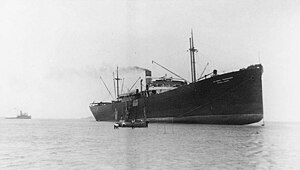
USS Freedom (ID-3024) was a cargo and transport ship in the United States Navy during World War I. Originally SS Wittekind for the North German Lloyd line, the ship also served as USAT Iroquois and USAT Freedom after being seized by the United States in 1917.
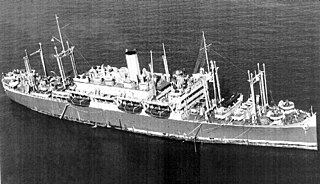
SS President Cleveland was originally built as Golden State for the United States Shipping Board (USSB), one of the planned World War I troop transports converted before construction into passenger and cargo vessels launched as Emergency Fleet Corporation Design 1029 ships first known, along with the smaller Design 1095 versions, in the trade as "State" ships due to names assigned for the nicknames of states and later as "535s" for their length overall. Almost all ships of both designs were renamed for United States presidents by May 1921, with Golden State being renamed President Cleveland. As one of the USSB-owned ships operated by agents of the board, President Cleveland was allocated to and operated by the Pacific Mail Steamship Company until sold by the USSB to the Dollar Steamship Line in 1925. After the demise of that line and creation of a new, replacement line, American President Lines, the ship remained with that line until government acquisition for the Second World War.

Built in 1918, the SS Santa Teresa was originally a passenger liner. In World War I she was requisitioned by the U.S. Navy and served under the title USS Santa Teresa. She served as a commercial vessel between the wars, first under her original name, and later as the SS Kent. During World War II she served first with the U.S. Army as the USAT Ernest Hinds, named for Major General Ernest Hinds. She was later part of the Navy as USS Kent (AP-28). She spent the final part of the war as an Army hospital ship, once more under the name USAT Ernest Hinds.
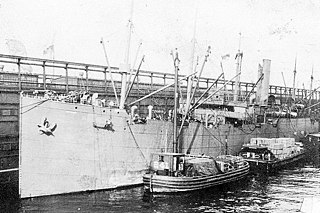
Empire Bittern was a steamship, built as a livestock-carrying cargo ship in 1902 at Belfast, Ireland as Iowa for the White Diamond Steamship Company Ltd of Liverpool. The ship was sold to the Hamburg Amerika Linie and renamed Bohemia in 1913.
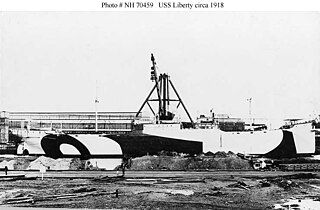
USAT Liberty was a United States Army cargo ship torpedoed by Japanese submarine I-166 in January 1942 and beached on the island of Bali, Indonesia. She had been built as a Design 1037 ship for the United States Shipping Board in World War I and had served in the United States Navy in that war as animal transport USS Liberty (ID-3461). She was also notable as the first ship constructed at Federal Shipbuilding, Kearny, New Jersey. In 1963 a volcanic eruption moved the ship off the beach, and Liberty's wreck is now a popular dive site.

SS El Occidente was a cargo ship for the Morgan Line, a subsidiary of the Southern Pacific Company. During World War I, she was known as USAT El Occidente in service with the United States Army and as USS El Occidente (ID-3307) in service with the United States Navy. At the end of war, she reverted to her original name of SS El Occidente.

MS West Grama, sometimes spelled as West Gramma, was a diesel-powered cargo ship of the United States Maritime Commission (USMC) that was sunk as part of the "gooseberry" breakwater off Utah Beach during the Normandy invasion. Prior to her diesel conversion, she was known as SS West Grama. In 1919, she was briefly taken up by the United States Navy under the name USS West Grama (ID-3794).
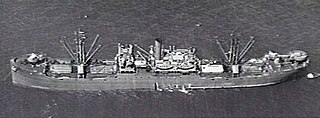
USS West Corum (ID-3982) was a cargo ship for the United States Navy in 1919. The ship was built as SS West Corum and reverted to that name at the end of her Navy service. During World War II, the ship was United States Army transport ship USAT West Corum, later renamed to Will H. Point.

USS General W. C. Gorgas (ID-1365) was a United States Navy troop transport in commission in 1919, named for William C. Gorgas. It was a German ship seized by the US Shipping Board after the US entered World War I. Under charter from 1917 from the Panama Railroad Company, it had carried troops and supplies to Europe. After being used as a troop transport to return troops from Europe in 1919, later that year it was converted back to commercial use as a passenger and freight ship operated by the Panama Railroad Company.

SS Lake Arthur (ID-2915) was a Design 1020 cargo ship that served in the Naval Overseas Transportation Service (NOTS) of the United States Navy during World War I. Originally ordered and begun under the name SS War Plum, she was renamed SS Lake Arthur by the United States Shipping Board (USSB). After her naval service, she operated commercially under a variety of names, before being scuttled in the North Sea with a load of chemical weapons in November 1945.

SS West Hosokie was a steel–hulled cargo ship built in 1918 as part of the World War I emergency wartime shipbuilding program organized by the United States Shipping Board.

SS West Gotomska was a steel–hulled cargo ship built in 1918 as part of the World War I emergency wartime shipbuilding program organized by the United States Shipping Board.
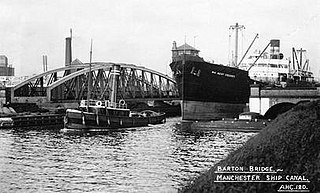
SS West Cressey was a steel-hulled cargo ship that saw a brief period of service as an auxiliary with the U.S. Navy in the aftermath of World War I.

SS West Loquassuck was a steel–hulled cargo ship built for the United States Shipping Board's Emergency Fleet Corporation in World War I. After completion on 15 October 1918, the ship was immediately commissioned into the U.S. Navy as USS West Loquassuck (ID-3638), just weeks before the end of the war.

SS West Mahomet was a steel–hulled cargo ship which saw service as an auxiliary with the U.S. Navy in 1918-19.

USS West Elcasco (ID-3661) was a steel-hulled cargo ship which saw service as an auxiliary with the U.S. Navy in World War I and as an Army transport in World War II.

USS West Haven (ID-2159) was a steel–hulled freighter that saw service with the U.S. Navy during World War I, and which later saw convoy service during the Battle of the Atlantic in World War II.

Western Maid was a 5,760 GRT cargo ship that was built in 1918 by the Northwest Steel Company, Portland, Oregon, USA. She was built for the United States Shipping Board (USSB), but was commissioned into the United States Navy on completion as USS Western Maid, with the pennant number ID-3703. In 1919 she was decommissioned and returned to the USSB. In 1937 she was passed to the United States Maritime Commission. In 1940 she was transferred to the British Ministry of Shipping and renamed Empire Cormorant, passing to the Ministry of War Transport (MoWT) in 1941. In 1945 she was scuttled in the North Atlantic with a cargo of obsolete war matériel.

USS Lake Tulare (ID-2652) was a cargo ship of the United States Navy that served during World War I and its immediate aftermath.
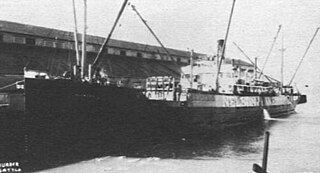
SS Arcata, was built in 1919 as the SS Glymont for the United States Shipping Board as a merchant ship by the Albina Engine & Machine Works in Portland, Oregon. The 2,722-ton cargo ship Glymont was operated by the Matson Navigation till 1923 in post World War I work. In 1923 she was sold to Cook C. W. of San Francisco. In 1925 she was sold to Nelson Charles Company of San Francisco. In 1937 she was sold to Hammond Lumber Company of Fairhaven, California. For World War II, in 1941, she was converted to a US Army Troopship, USAT Arcata. She took supplies and troops to Guam. On July 14, 1942, she was attacked by Japanese submarine I-7 and sank. She was operating as a coastal resupply in the Gulf of Alaska, south of the Aleutian Islands at, approximately 165 nautical miles southeast of Sand Point, when she sank. She was returning after taking supplies to Army troops fighting in the Aleutian Islands campaign.
